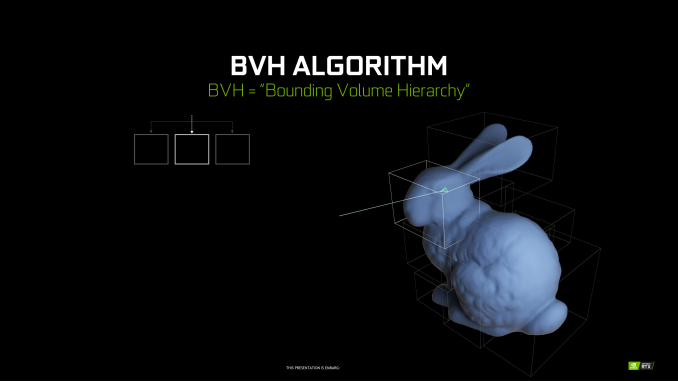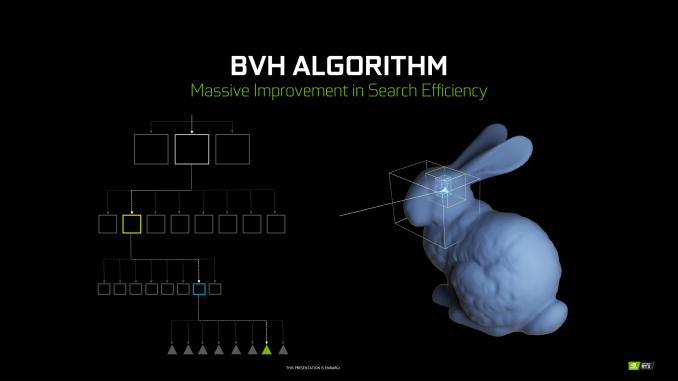The NVIDIA Turing GPU Architecture Deep Dive: Prelude to GeForce RTX
by Nate Oh on September 14, 2018 12:30 PM ESTBounding Volume Hierarchy - How Computers Test the World
Perhaps the biggest aspect of NVIDIA’s gamble on ray tracing is that traditional GPUs just aren’t very good at the task. They’re fast at rasterization and they’re even fast at parallel computing, however ray tracing does not map very well to either of those computing paradigms. Instead NVIDIA has to add hardware dedicated to ray tracing, which means devoting die space and power to hardware that cannot help with traditional rasterization.
A big part of that hardware, in turn, will go into solving the most basic problem of ray tracing: how do you figure out what a ray is intersecting with? The most common solution to this problem is to store triangles in a data structure that is well-suited for ray tracing. And this data structure is called a Bounding Volume Hierarchy.
Conceptually, a BVH is relatively simple – at least for the purposes of this article. Rather than testing every polygon to see if a ray interacts with it, the idea is to test a portion of a scene to see if it interacts with a ray, and then keep drilling down. If there is an intersection with that portion of the scene, then subdivide it into smaller portions and test again. And again. And again. All the way until you reach the individual polygon, at which point the ray testing is resolved.
For the computer scientists in the crowd, this might sound a lot like an application of a binary search, and it is. Each test allows for a significant number of options (in this case polygons) to be discarded as possible answers. This gets to the right polygon in just a fraction of the time. A BVH, in turn, is stored in what’s essentially a tree data structure, with each subdivision – called bounding boxes – stored as children of their parent bounding box.
Now the catch with BVH is that while it radically cuts down on the amount of ray intersection needed compared to a naïve implementation, it’s still not super cheap. A number of tests are still required for each ray, with both successful and failed tests adding to the total number of tests taken. And all of this is for a single ray, when a significant number of rays are going to be needed for each pixel. Which is why hardware acceleration of the process is so important (and not at all easy).
The other major computational cost here is that BVHs themselves aren’t free. One needs to be created for a scene from the polygons in it, so there is an additional step before ray casting can even begin. This is more a developer concern – when can they modify and reuse a BVH versus building a new one – but it’s another step in the process. Furthermore it’s an example of why developer training and efficient engine implementations are so crucial to the process, as a poor implementation can make ray tracing much too slow to be viable.













111 Comments
View All Comments
Yojimbo - Saturday, September 15, 2018 - link
The sites I look at put $649 2013 dollars at about $700 today. They use the CPI, the Consumer Price Index. That is the standard way to compare values over consumer goods and cost of living in general between different years where the CPI has been recorded. I have no idea where the numbers in your chart have come from. For instance, by the CPI, the 7800 GTX 512, which was released in 2005, is about $840 in 2018 dollars, and $825 in 2017 dollars, far more than the $783 listed in your chart.Note that if you have a steady 2% inflation per year over 13 years you get a 29% increase in prices.
Yojimbo - Saturday, September 15, 2018 - link
And besides, your chart, even with the wrong numbers, doesn't show what you claim to show. The 780, the 280, the 8800 GTX, and the 7800 GTX all have launch prices around the RTX 2080, even though the RTX 2080 has a bigger die than any of them.eddman - Saturday, September 15, 2018 - link
Yes it does. 2080 Ti is the most expensive geforce launch card. It's not my job, as a buyer, to dig up die sizes or even care about them. I only care about performance/price ratios which these cards are terrible at.eddman - Saturday, September 15, 2018 - link
... they are terrible because the price/performance ratio hasn't improved in any substantial way. 1080 Ti offered ~70% performance increase over 980 Ti for just ~8% higher launch MSRP.Yojimbo - Saturday, September 15, 2018 - link
OK, so when GM produced the Hummer that's directly comparable to their Suburban because they were both SUVs. It's not your job to be an intelligent creature and realize that the Hummer opened up a new market segment. Instead, spend your energy resenting GM. You can do what you want but that doesn't make it rational.eddman - Sunday, September 16, 2018 - link
... except a Hummer is a Hummer and a Suburban is a Suburban. They are not part of the same lineup. Also, a car is not a video card.2080 Ti directly follows 1080 Ti based on the naming. It's not my fault they did it. They could've named it 2090 Ti if they really meant it to be a different product category, but they didn't so based on common branding logic 2080 Ti is the successor to 1080 Ti and therefore it is not out-of-the-ordinary to expect close pricing.
Rational? What I wrote is completely rational. It is you who is trying to somehow make it look that a ~42% price jump for a 40%-45% performance increase in regular rasterized games is ok. It is not. This is probably the worst generational price/performance ratio vs. the old gen I've seen.
eddman - Sunday, September 16, 2018 - link
... unless they plan on releasing GTX 2080 Ti/2080 at lower prices, but given the potential confusion that it might cause, probably not.0ldman79 - Sunday, September 16, 2018 - link
Oddly enough, going by that comparison the H2 is built on the same platform as the Suburban.Killmorefor - Sunday, September 16, 2018 - link
That chart is pretty accurate, but would benefit from a 3D showing price drops after the next gen introduction. The chart apples, and but does not show the price jump before the chart started, nor the current jump for the next gen the OP has very good point.markiz - Monday, September 17, 2018 - link
Yeah, so what?I don't understand.. If the price is too high, they will not sell much.